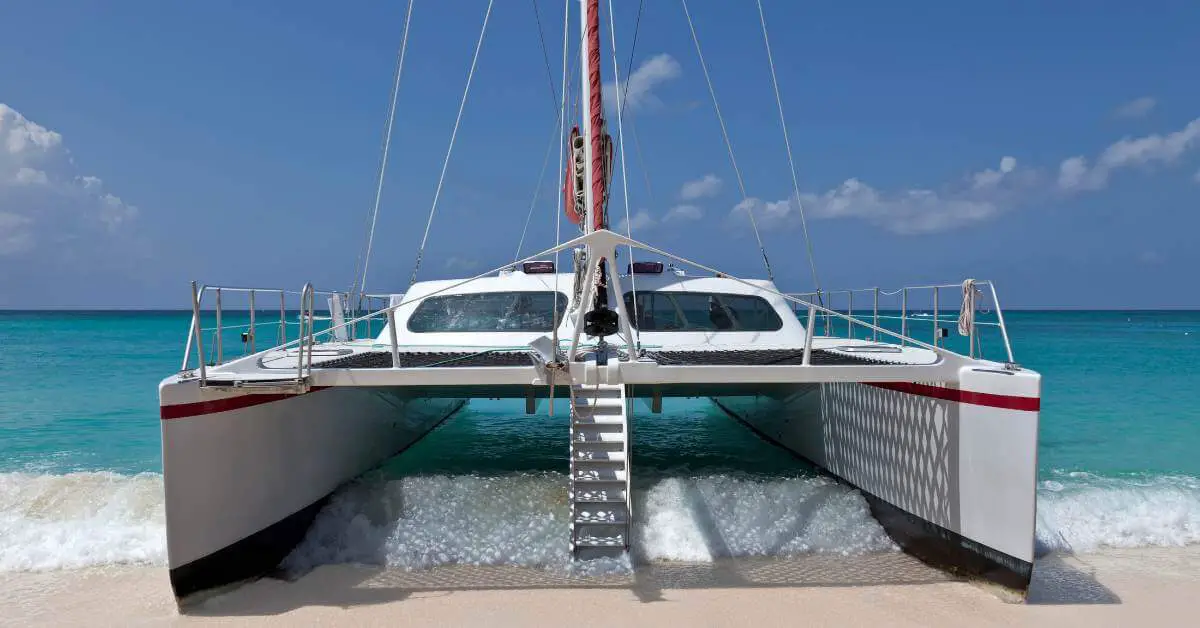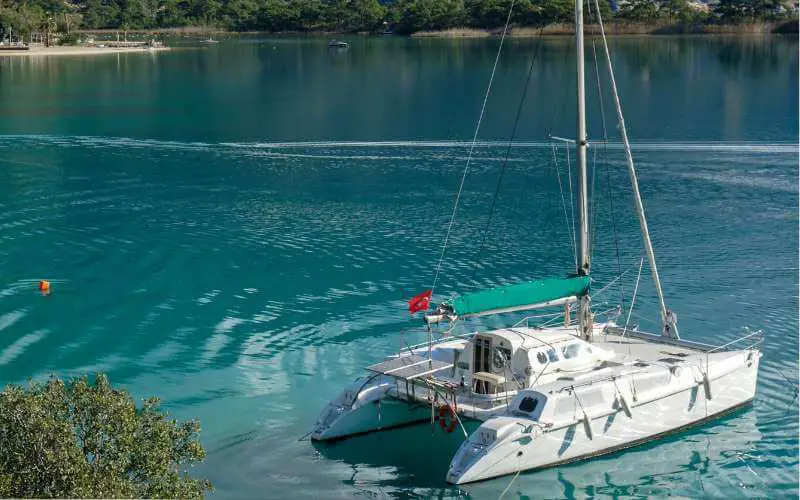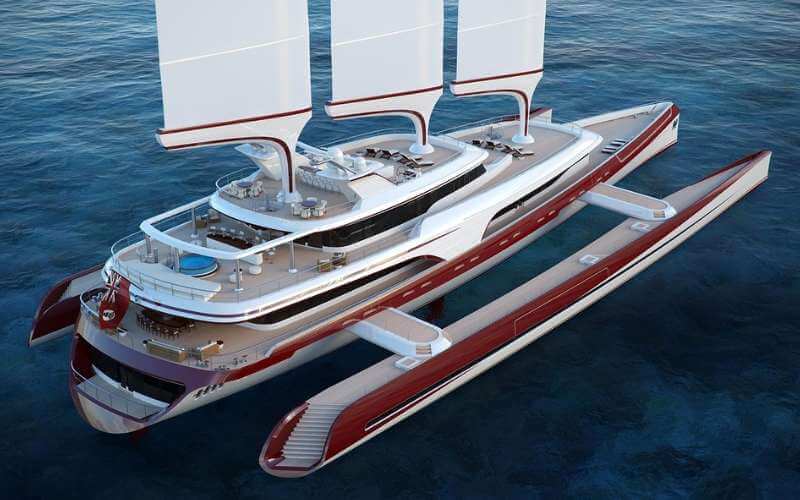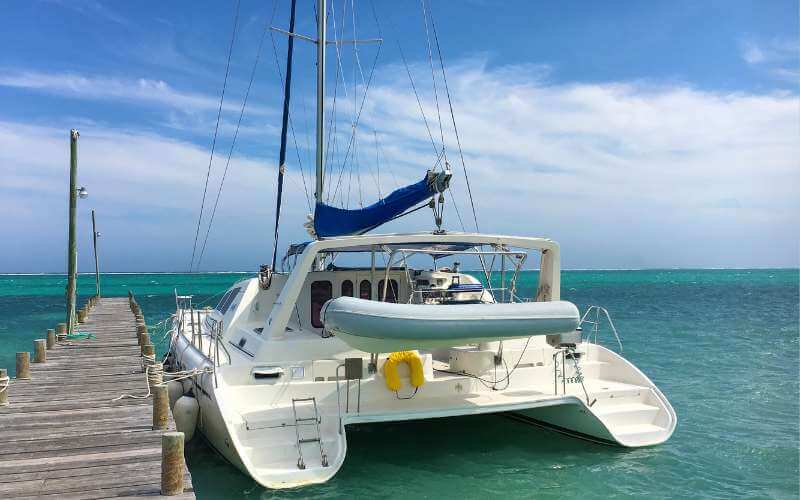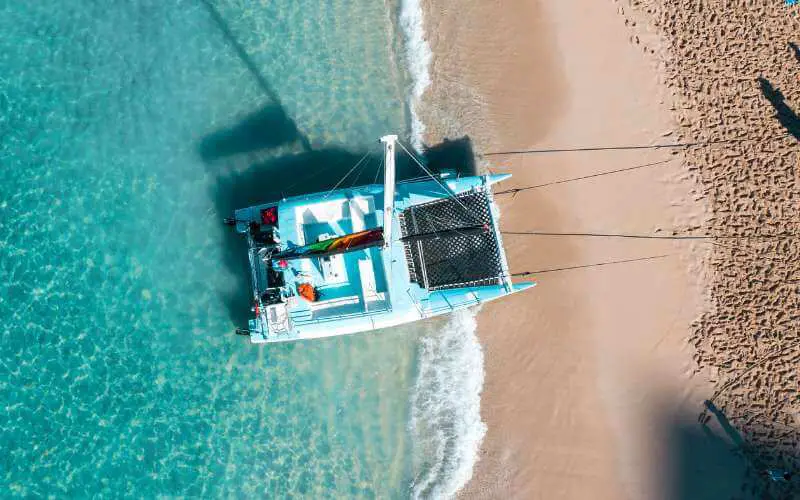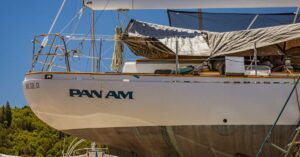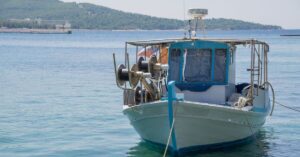Diving into the world of catamarans, those magnificent vessels revolutionized the boating industry with their stability, speed, and remarkable spaciousness. The secret to their superiority? It’s all in the design, with two sleek hulls, side by side, linked by a bridge deck. That’s the design secret that set them apart from traditional single-hulled vessels.
Catamarans have become the first-choice vessel for sailors, cruising fans, and yacht chartering enthusiasts with their exceptional stability, unparalleled comfort, and outstanding performance, even under challenging weather conditions.
So, get ready to reveal the charm and brilliance of these awesome watercraft.
What is a Catamaran?
A catamaran is a type of yacht or boat characterized by its unique design featuring two parallel hulls connected by a bridge deck. This twin-hulled structure sets catamarans apart from traditional monohull boats and offers a range of advantages that have made them increasingly popular in the boating world.
Stability sits at the top of a catamaran’s list of advantages. The two hulls offer a broad base, significantly enhancing stability even in rough waters.
In addition to stability, catamarans hold a reputation for their spaciousness; a feature monohull boats find hard to match. A catamaran offers an inviting living space above and below the deck thanks to the wide spacing between the dual-hull structure.
Catamarans come in various sizes, from compact versions perfect for a day’s sail to larger variants designed for extended cruising or fishing. This versatility enables each boater to find a catamaran that fits their specific needs and desires.
Catamaran vs. Monohull
In the world of boats, the choice between a catamaran and a monohull is pivotal. Both boats offer unique advantages and face their challenges. Being aware of these differences can guide you in making a well-informed decision. Let’s explore some of these differences:
Sailing Performance
Thanks to their dual-hulled design, catamarans are known for their speed and stability. This configuration enables them to move through the water with minimal resistance, resulting in higher average speeds.
Conversely, Monohulls have one hull to navigate through the water, which may result in a marginally slower sailing experience.
Maneuverability
Catamarans gain the upper hand in shallow waters with their twin hulls. The twin hulls allow it to have a shallower draft, meaning that it can sail in waters that are too shallow for monohulls.
This grants catamaran owners access to exploring remote coves and anchoring in secluded bays, mostly inaccessible to monohulls.
Catamarans are appreciated for their tight turning circles and easing handling in marinas and tight spaces. However, monohulls boast superior maneuverability under sail due to their single-keel design.
Comfort
Catamarans offer ample space due to their wide beam. The dual hulls facilitate generous living space on the deck and below, providing room for multiple cabins, saloons, and well-equipped kitchens.
In contrast, monohulls offer a traditional sailing experience with their characteristic lean and heel, which some sailing purists prefer.
Cost
Catamarans, especially larger ones, are often costlier than monohulls. This is due to the increased materials and labor required to build a catamaran’s twin hulls. Furthermore, the larger sail area and rigging of catamarans can lead to increased maintenance costs.
However, catamarans typically have higher resale values due to their popularity and demand in the market.
Catamaran Vs Trimaran
For sailing enthusiasts ready to explore the open waters, multiple choices for the type of boat with varied options. Among these, catamarans and trimarans are two popular choices that offer distinct features and benefits.
Both catamarans and trimarans are designed with multiple hulls. These boats have unique features catering to different sailing preferences and conditions.
Let’s explore some of differentiating factors between these two unique vessels:
Number of Hulls, Performance & Stability
As its name implies, a catamaran features two parallel hulls, while a trimaran three hulls. The hull count influences the boat’s stability, maneuverability, and overall performance on the water.
Catamarans are widely recognized for their exceptional stability and sailing performance. The twin-hulled design provides a large and stable platform on the water. With a wide beam and low center of gravity of a catamaran make it less likely to tip or heel dramatically during sailing, contributing to an overall sense of safety and stability onboard.
In contrast, trimarans, with their three hulls, offer a unique combination of stability and speed. The central hull, or the “ama,” is typically larger, offering buoyancy and stability. Two smaller hulls, known as the outriggers or “amas,” further contribute to stability and help counterbalance the forces acting on the boat. This tri-hulled design allows trimarans to sail at high speeds while maintaining stability.
While both catamarans and trimarans offer exceptional stability, catamarans generally have a wider beam. The twin-hulled catamaran design provides ample living space above and below the deck. Nonetheless, the narrower beam of trimarans may restrict the space available for living and other features. However, trimarans are still ideal for those prioritizing performance and exhilaration on the water.
Maneuverability
With their dual hulls, catamarans have a distinct edge in shallow waters and constrained spaces. Their design provides a shallower draft, opening up exploration opportunities in shallow anchorages and exploring areas inaccessible to monohulls or even trimarans.
The twin-hulled design enables catamarans to efficiently deliver tight turning circles, making them highly maneuverable in marinas and crowded harbors.
Despite showcasing excellent maneuverability, Trimarans may experience comparatively deeper drafts due to the additional hull, potentially restricting their access to certain shallower areas.
Sailing Experience
Due to their wide beam and sturdy build, catamarans generally experience minimal heeling or leaning while sailing.
In contrast, trimarans might experience slight leaning during sailing, giving sailors a more traditional sailing experience that may be attractive to some sailors.
Cost
Assessing the cost between catamarans and trimarans can be complex. The final price tag usually depends on factors such as design intricacies, construction complexity, and the equipped amenities on the boat.
With their multi-hulled design, both catamaran and trimaran often demand more materials and craftsmanship, which can escalate the total cost. These boats typically have larger sails and rigging, increasing maintenance expenses.
Nonetheless, the cost will hinge significantly on the quality and sophistication of the design and equipment involved; hence, categorically declaring a cheaper option may be challenging.
Types of Catamarans (Sailing Catamarans Vs. Power Catamarans)
Catamarans are available in various shapes and sizes, catering to boating requirements and preferences. Sailing and power catamarans are the main types, each having distinct features and advantages.
Sailing Catamarans
Sailing Catamarans are designed with the thrill of cruising the sea under wind power. They offer excellent stability, a desirable trait for those seeking a smooth experience even in rough waters. The wide beam minimizes seasickness risks and lends itself well to overnight cruises.
Regarding propulsion systems, Sailing Catamarans use wind force captured by sails for movement. This natural, renewable energy source offers an eco-friendly and tranquil boating experience.
However, modern sailing catamarans also have auxiliary engines that assist during calm winds or intricate maneuvering in harbors.
Power Catamarans
Power catamarans are designed for those who prioritize speed and efficiency. These particular catamarans are equipped with powerful engines that facilitate them to reach high speeds effortlessly.
While the fundamental design of Power Catamarans mirrors that of Sailing Catamarans – the wide beam with dual hulls – the power source differs dramatically. The twin-engine setup (one per hull) allows for higher cruising speeds and improved maneuverability.
Power catamarans are known for their superior fuel efficiency, an essential consideration for day-long expeditions. Despite prioritizing speed, they don’t sacrifice comfort; the power catamaran’s design boasts spacious interiors similar to Sailing Catamarans.
Advantages of Catamaran Boats
Catamaran boats offer numerous benefits, making them an attractive option for experienced sailors and those new to boating.
1. Stability: Catamarans offer increased stability over monohull boats due to their wider base and even weight distribution. This stability is noticeable during sailing, anchoring, and even when exploring shallow waters, providing a more comfortable experience for passengers.
2. Shallow Draft: Catamarans can easily navigate in shallow waters due to their low draft. This feature allows for exploring narrow coastal areas, coves, and bays that may be inaccessible to larger monohull boats.
3. Comfort and Space: The parallel hulls of a catamaran create more living space. This includes a spacious kitchen or galley, comfortable sleeping quarters, generous storage space, and a large multipurpose deck area.
4. Power and Speed: Catamarans are known for their speed and performance. Their twin-hull design reduces wind and water resistance, allowing for increased speed. Their shallow draft also allows faster navigation in shallow waters or narrow paths.
5. Fuel Efficiency: Catamaran’s design contributes to their fuel efficiency. The wider base reduces drag, while its stability allows for constant sailing without extensive adjustments, leading to less fuel consumption.
6. Redundant Equipment: With duplicate systems and backup options for essential systems such as engines, steering, and electrical systems, ensuring uninterrupted functionality and safety even in the event of a failure or mechanical issue.
Drawbacks of Catamarans
While catamarans have unique design advantages making them popular, they also present certain limitations.
1. Responsiveness: Catamarans have less responsiveness due to their wider beam and twin hulls. This means they require more effort and time to turn, particularly in tight spaces or crowded marinas.
2. Pounding in rough seas: Catamarans may experience a pounding sensation when encountering large waves, causing discomfort and potentially increasing damage risk.
3. Wider beam challenges: The wider beam of catamarans can make finding suitable docking spaces difficult in crowded marinas or tight anchorages. Navigating through narrow channels or under bridges can also prove challenging.
4. Fuel efficiency at high speed: In strong headwinds or rough seas, the reduced drag of a catamaran increases speed but requires more fuel to maintain the higher speed.
5. Higher purchase and maintenance price: Catamarans often have higher purchase prices. The double hulls and equipment lead to increased maintenance costs and potential failures. Also, catamarans often require wider slips or specific berthing arrangements, resulting in potentially higher costs.
6. Sailing Performance: Due to their wider beam, Catamarans struggle to sail close to the wind. Their larger wetted surface area can create more drag when sailing upwind, impacting their performance in stronger wind conditions.
It is important for potential catamaran owners and operators to carefully consider these factors and choose a vessel that aligns with their specific needs and intended usage.
Tips for Sailing a Catamaran
Sailing a catamaran is an exciting experience but demands unique handling skills & knowledge. For a smooth sailing adventure with a catamaran, keep in mind the following tips:
1. Know Your Catamaran’s Design: Familiarize yourself with the boat’s layout, controls, sails adjustment, handling the rigging, and engine operation before setting sail. If necessary, understand how to operate the engines to ensure a safe journey.
2. Monitor Weather Conditions: Always check the weather forecast before departure. Remember, a catamaran’s wide beam makes it susceptible to strong wind gusts, so adjust your sails and course accordingly to maintain control.
3. Practice Maneuvering: Operating a catamaran requires skill and caution, particularly in tight spaces like marinas or crowded harbors. Practice maneuvering skills in open waters before docking or anchoring in challenging areas. Know how to use the engines efficiently for forward, backward, and sideways movements, keeping the boat’s draft in mind to avoid grounding or hitting reefs that could harm the hulls.
4. Know Your Depths: One of the major considerations when sailing catamarans is their draft – the minimum depth of water a boat sinks to when loaded. Being aware of the draft of your catamaran prevents you from running aground or damaging the hulls on underwater obstacles or shallow areas. Regularly use your depth finder, follow up-to-date nautical charts, and remember that conditions can change rapidly.
5. Harness the Wind: To maximize your sailing efficiency, understand and use the best sailing angles for your catamaran since this varies among different catamaran models. Learn how to trim your sails properly to harness wind power effectively and constantly watch for wind direction and speed changes to adjust accordingly.
6. Maintain Your Catamaran: Regular maintenance of your catamaran is crucial to ensure its optimal performance and longevity. Establish a routine check for potential issues, including regular hull inspections, rigging wear and tear, and engine checks if applicable. Cleaning the vessel regularly prevents algae build-up and exposes hidden potential issues that might otherwise be overlooked.
7. Plan Your Berthing: The increased beam size of a catamaran compared to monohull sailing yachts means you’ll need a wider space for berthing. Pre-planning your berthing locations can save you from avoidable berthing complications. Always approach the berth safely and slowly, and be mindful of surrounding boats and hazards.
8. Prioritize Safety: While the stability of catamarans can make them feel exceptionally safe, it’s important never to compromise on safety standards. Ensure everyone on board is familiar with basic safety protocols, knows how to use lifesaving equipment, and knows where it’s stored. Regular checks and upkeep of safety gear, including lifejackets, fire extinguishers, and flare kits, are essential.
Remember, these starting tips merely scratch the surface regarding sailing catamarans. Continuous learning and accruing experience on the water are crucial to becoming a skilled catamaran sailor.
Catamaran Boats FAQs
When it comes to catamarans, several questions are often circulating in the minds of novice and seasoned sailors. Let’s address some of these commonly asked questions:
What is the difference between a catamaran and a monohull boat?
The most significant differences between a catamaran and a monohull boat are their hull design. Catamarans feature two hulls connected by a bridge deck, while monohulls have a single hull.
Key advantages of catamarans include greater stability, spacious living areas, and a shallower draft. Conversely, monohulls are typically known for their traditional sailing experience and ability to slice through waves.
How does the cost of a catamaran compare to a monohull?
Catamarans are generally more expensive than monohull boats of similar size and features due to the increased materials, labor, and engineering necessary to build them.
Furthermore, catamarans might have higher maintenance and operating expenses due to their dual hulls and larger living spaces. However, it’s important to remember that catamarans provide more living space and stability for those who value comfort and spaciousness.
What is the typical draft of a catamaran?
A catamaran’s draft refers to the hull’s depth below the waterline. Catamarans are known for their shallow draft, which allows them to navigate in shallower waters compared to monohull boats.
The specific draft varies depending on a catamaran’s size and design but typically ranges from 2 to 5 feet. This shallow draft is advantageous in coastal areas, island hopping, or exploring shallow-water destinations.
Can catamarans be used for racing?
Yes, catamarans have become increasingly popular in the realm of sailing races. Racing catamarans are designed with lightweight materials and streamlined hulls that enable them to reach remarkable speeds.
They also feature advanced sail systems that boost performance, such as rotating masts and asymmetrical spinnakers. Catamaran racing is both exhilarating for participants and a fascinating spectacle for spectators.
Are catamarans suitable for long-distance cruising?
Catamarans are well-suited for long-distance cruising due to their stability, spacious living areas, and efficient sailing capabilities. With their wider beam and dual hulls, catamarans offer abundant living space above and below the deck.
This makes them comfortable for extended periods on the water, providing ample room for supplies, equipment, and socializing. Furthermore, the impressive stability of catamarans allows for a smoother ride, even in rough seas.

